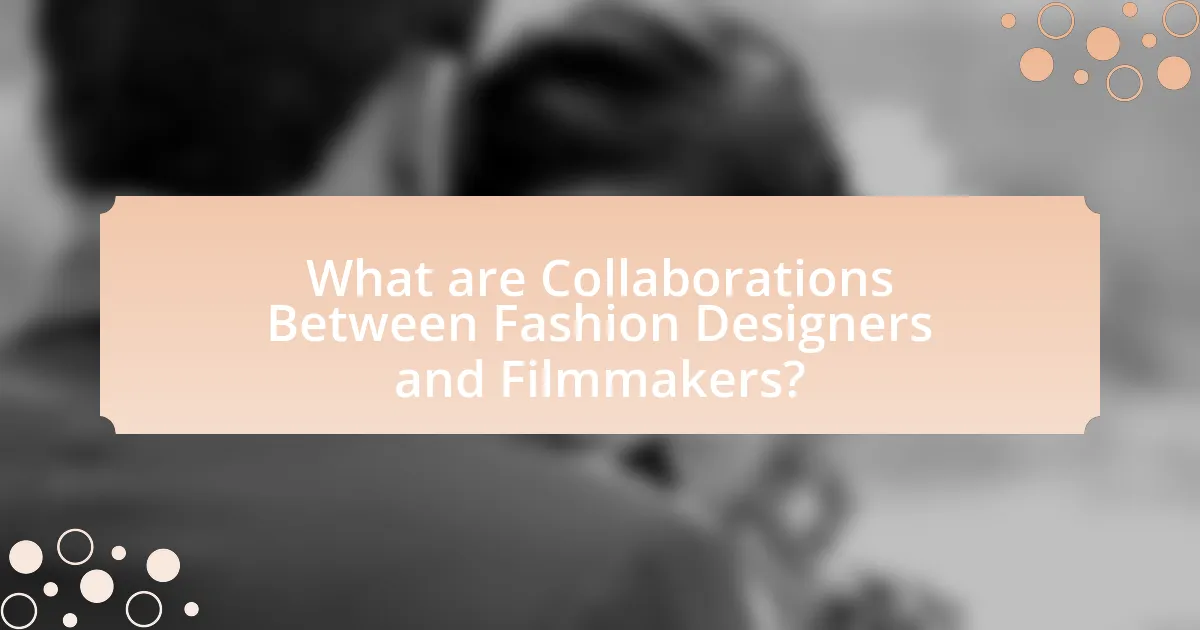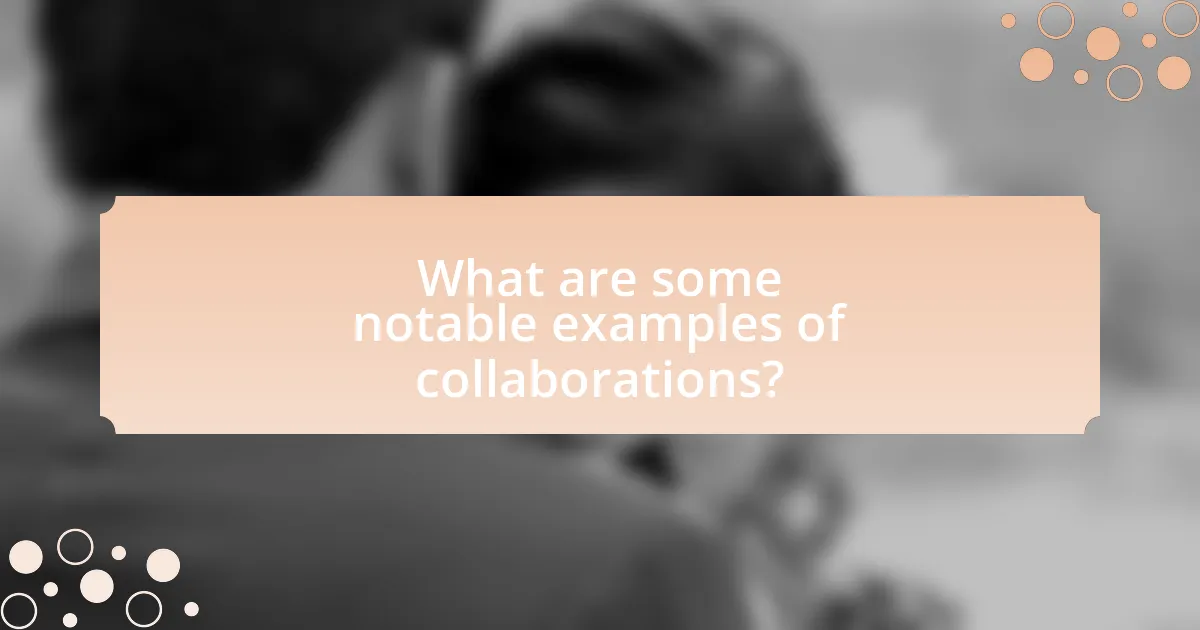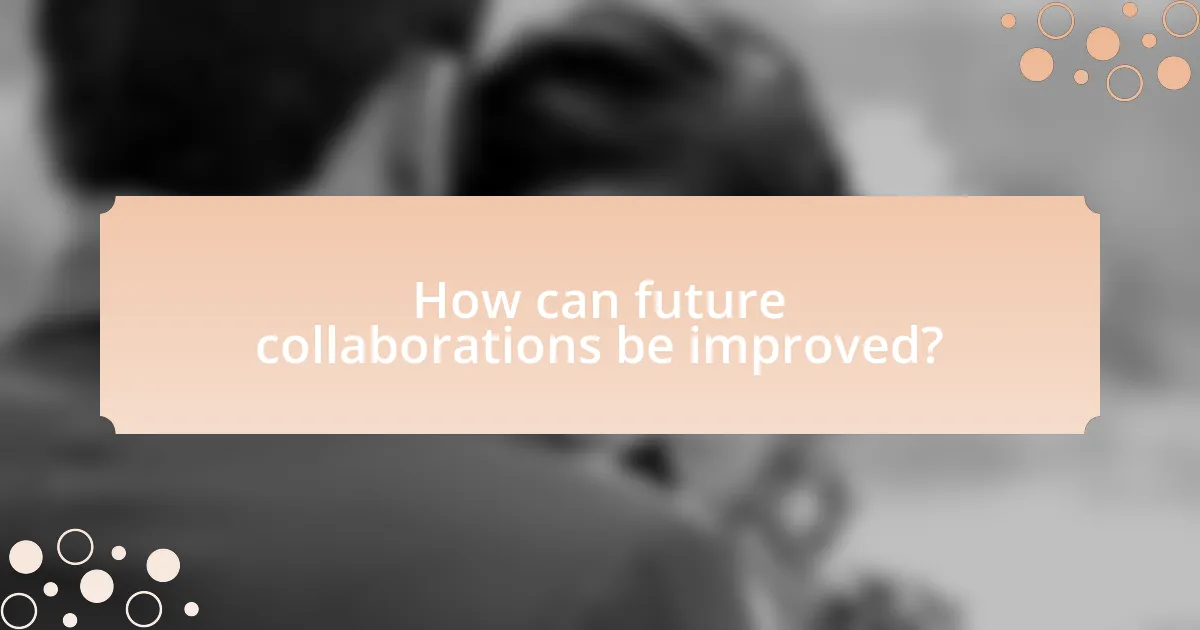Collaborations between fashion designers and filmmakers represent a significant intersection of creative industries, enhancing cinematic storytelling through costume design and styling. These partnerships result in iconic visuals that define characters and influence fashion trends, as exemplified by films like “The Great Gatsby” and “The Devil Wears Prada.” The article explores the roles of designers in film production, the impact of filmmakers on fashion, notable collaborations, and the cultural significance of these partnerships. Additionally, it addresses challenges faced in these collaborations and offers strategies for improving communication and aligning creative visions, while highlighting emerging trends influenced by technology and sustainability.

What are Collaborations Between Fashion Designers and Filmmakers?
Collaborations between fashion designers and filmmakers involve the integration of fashion aesthetics into cinematic storytelling, enhancing visual narratives through costume design and styling. These partnerships often result in iconic looks that define characters and influence fashion trends, as seen in films like “The Great Gatsby,” where costume designer Catherine Martin worked closely with designer Miuccia Prada to create a distinctive 1920s style. Such collaborations not only elevate the film’s artistic value but also provide designers with a platform to showcase their work to a broader audience, thereby merging the worlds of fashion and film in a mutually beneficial relationship.
How do these collaborations typically manifest in the industry?
Collaborations between fashion designers and filmmakers typically manifest through joint projects that integrate fashion into film narratives, enhancing visual storytelling. These partnerships often result in costume design that reflects the film’s themes, as seen in iconic films like “The Great Gatsby,” where costume designer Catherine Martin collaborated with director Baz Luhrmann to create a visually stunning representation of the Roaring Twenties. Additionally, fashion designers may create exclusive collections inspired by films, such as the collaboration between Gucci and the film “Gucci,” which showcased the brand’s aesthetic in a cinematic context. These collaborations not only elevate the film’s artistic value but also promote the fashion brand, demonstrating a symbiotic relationship that benefits both parties.
What roles do fashion designers play in film production?
Fashion designers play crucial roles in film production by creating costumes that define characters and enhance storytelling. They collaborate closely with directors and producers to ensure that the wardrobe aligns with the film’s vision, period, and setting. Designers conduct research on historical fashion and cultural contexts to accurately represent characters, which can significantly impact audience perception and engagement. For instance, in films like “The Great Gatsby,” costume designer Catherine Martin’s work was pivotal in conveying the opulence of the 1920s, earning her Academy Awards for Best Costume Design. This illustrates how fashion designers not only contribute to the visual aesthetics of a film but also help in character development and narrative depth.
How do filmmakers influence fashion design through their projects?
Filmmakers influence fashion design through their projects by showcasing specific styles and trends that resonate with audiences, thereby driving consumer demand. For instance, films like “The Great Gatsby” (2013) led to a resurgence of 1920s fashion, with designers like Miuccia Prada creating collections inspired by the film’s aesthetic. This direct correlation between cinematic visuals and fashion trends is evident in the way costume design often sets the tone for what becomes fashionable in real life, as seen with the popularity of vintage styles following the release of period films. Additionally, collaborations between filmmakers and fashion designers, such as the partnership between director Sofia Coppola and fashion house Chanel, further solidify this influence by merging cinematic storytelling with high fashion, creating iconic looks that are emulated by the public.
Why are collaborations between fashion designers and filmmakers significant?
Collaborations between fashion designers and filmmakers are significant because they create a unique synergy that enhances both visual storytelling and fashion innovation. This partnership allows filmmakers to incorporate cutting-edge fashion into their narratives, thereby elevating the aesthetic appeal of their films. For instance, the collaboration between designer Alexander McQueen and filmmaker David LaChapelle resulted in visually stunning works that pushed the boundaries of both fashion and film. Such collaborations not only influence trends but also shape cultural perceptions of style and identity, as seen in films like “The Devil Wears Prada,” which showcased high fashion within a cinematic context.
What cultural impacts arise from these collaborations?
Collaborations between fashion designers and filmmakers significantly influence cultural trends and perceptions. These partnerships often result in the blending of visual storytelling and fashion, leading to innovative aesthetics that shape public taste. For instance, films like “The Devil Wears Prada” have not only popularized specific fashion styles but also elevated the status of fashion as a form of art and expression. Additionally, such collaborations can challenge societal norms and promote diversity by showcasing varied cultural narratives and identities, as seen in films like “Black Panther,” which highlighted African culture through its costume design. This intersection of fashion and film fosters a dialogue about identity, creativity, and cultural representation, ultimately impacting how audiences engage with both mediums.
How do these partnerships enhance storytelling in film?
Partnerships between fashion designers and filmmakers enhance storytelling in film by integrating visual aesthetics that deepen character development and thematic expression. For instance, the collaboration allows filmmakers to utilize fashion as a narrative tool, where costumes reflect a character’s personality, social status, and emotional journey. A notable example is the film “The Great Gatsby,” where costume designer Catherine Martin’s work visually articulates the opulence and decadence of the 1920s, reinforcing the film’s themes of aspiration and disillusionment. This synergy not only enriches the visual narrative but also engages audiences on a deeper emotional level, making the storytelling more immersive and impactful.

What are some notable examples of collaborations?
Notable examples of collaborations between fashion designers and filmmakers include the partnership between Miuccia Prada and director Wes Anderson for the film “The Grand Budapest Hotel,” where Prada designed costumes that reflected the film’s unique aesthetic. Another significant collaboration is between Gucci and director Harmony Korine for the film “Spring Breakers,” where Gucci’s designs played a crucial role in shaping the film’s visual narrative. Additionally, the collaboration between Jean-Paul Gaultier and director Pedro Almodóvar in films like “Kika” showcases how fashion can enhance character development and storytelling. These collaborations illustrate the impactful intersection of fashion and film, where designers contribute to the visual storytelling and thematic depth of cinematic works.
Which fashion designers have successfully collaborated with filmmakers?
Fashion designers who have successfully collaborated with filmmakers include Giorgio Armani, who designed costumes for films like “The Untouchables,” and Miuccia Prada, known for her work on “The Great Gatsby.” Additionally, Jean-Paul Gaultier created iconic costumes for “The Fifth Element,” while Alexander McQueen’s designs were featured in “The Hunger Games.” These collaborations have significantly influenced both fashion and film, showcasing the intersection of these creative industries.
What specific films showcase these collaborations?
Specific films that showcase collaborations between fashion designers and filmmakers include “The Devil Wears Prada,” featuring costume design by Patricia Field, and “Phantom Thread,” which highlights the work of designer Mark Bridges. These films exemplify the integration of fashion into cinematic storytelling, with “The Devil Wears Prada” reflecting the fashion industry’s influence on personal identity and “Phantom Thread” showcasing the intricate relationship between fashion and character development.
How did these collaborations influence the fashion industry?
Collaborations between fashion designers and filmmakers significantly influenced the fashion industry by merging cinematic storytelling with fashion aesthetics, thereby enhancing brand visibility and cultural relevance. For instance, the partnership between Gucci and director Ridley Scott for the film “House of Gucci” not only showcased the brand’s historical context but also revitalized interest in its designs, leading to a reported 20% increase in sales following the film’s release. Such collaborations create a platform for designers to reach broader audiences, as seen with the success of films like “The Devil Wears Prada,” which propelled the fashion house Prada into mainstream consciousness, demonstrating the powerful synergy between film and fashion.
What challenges do fashion designers and filmmakers face in collaborations?
Fashion designers and filmmakers face several challenges in collaborations, primarily related to differing creative visions and communication barriers. These challenges often stem from the distinct objectives of each discipline; designers focus on aesthetics and garment functionality, while filmmakers prioritize narrative and visual storytelling. This divergence can lead to conflicts over design choices, timelines, and budget allocations. Additionally, the collaborative process may be hindered by inadequate communication, resulting in misunderstandings about project goals and expectations. Research indicates that successful collaborations require clear dialogue and alignment on creative direction, as evidenced by case studies where misalignment led to project delays and unsatisfactory outcomes.
How do creative differences impact the collaboration process?
Creative differences can significantly impact the collaboration process by leading to conflicts or enhanced innovation. When fashion designers and filmmakers have differing visions, it can create tension that may hinder progress. However, these differences can also stimulate creative problem-solving, resulting in unique and innovative outcomes. For instance, a study published in the Journal of Creative Behavior found that diverse perspectives often lead to higher-quality creative outputs, as teams that embrace differing viewpoints tend to explore a wider range of ideas and solutions. Thus, while creative differences can pose challenges, they can also serve as a catalyst for creativity and innovation in collaborative projects.
What logistical issues can arise during these partnerships?
Logistical issues that can arise during collaborations between fashion designers and filmmakers include miscommunication regarding timelines, resource allocation, and creative vision alignment. These partnerships often involve tight schedules where delays in costume design or production can disrupt filming timelines, as seen in the collaboration between designer Alexander McQueen and filmmaker David LaChapelle, where last-minute changes led to significant delays. Additionally, discrepancies in budget management can lead to conflicts, as both parties may have different expectations regarding costs associated with materials and labor. Furthermore, logistical challenges such as transportation of costumes and equipment can complicate on-location shoots, particularly if the designer and filmmaker are based in different regions, which was evident in the collaboration between Gucci and the film “A Single Man,” where logistical coordination was critical to meet production deadlines.

How can future collaborations be improved?
Future collaborations can be improved by establishing clear communication channels and shared goals between fashion designers and filmmakers. Effective communication ensures that both parties understand each other’s creative visions and constraints, which can lead to more cohesive and innovative outcomes. Research indicates that projects with defined objectives and regular check-ins are 30% more likely to succeed, as they foster alignment and reduce misunderstandings. Additionally, incorporating collaborative tools and platforms can streamline the workflow, allowing for real-time feedback and adjustments, ultimately enhancing the collaborative process.
What best practices should be followed for successful collaborations?
Successful collaborations between fashion designers and filmmakers require clear communication, defined roles, and mutual respect. Clear communication ensures that both parties understand the project’s vision and objectives, which is essential for aligning creative efforts. Defined roles help in establishing accountability, allowing each participant to focus on their strengths, whether in design or storytelling. Mutual respect fosters a collaborative environment where ideas can be freely exchanged, leading to innovative outcomes. Research indicates that effective collaboration can enhance creativity and lead to successful projects, as seen in various case studies within the fashion and film industries.
How can communication be enhanced between designers and filmmakers?
Communication between designers and filmmakers can be enhanced through regular collaborative meetings and the use of shared digital platforms. Regular meetings facilitate the exchange of ideas, ensuring that both parties are aligned on creative visions and project goals. Utilizing shared digital platforms, such as project management tools and collaborative design software, allows for real-time feedback and updates, streamlining the workflow. Research indicates that effective communication strategies, including visual storytelling and mood boards, can significantly improve collaboration outcomes in creative projects, as they provide clear visual references that bridge the gap between different disciplines.
What strategies can be implemented to align creative visions?
To align creative visions between fashion designers and filmmakers, establishing clear communication channels is essential. This involves regular meetings to discuss ideas, expectations, and feedback, ensuring that both parties understand each other’s artistic goals. Additionally, creating a shared vision board can visually represent the desired outcomes, fostering collaboration and minimizing misunderstandings. Research indicates that successful collaborations often rely on mutual respect and an openness to compromise, which can enhance the creative process and lead to innovative results. For instance, the collaboration between designer Alexander McQueen and filmmaker David LaChapelle exemplifies how aligned visions can produce groundbreaking work, showcasing the importance of strategic alignment in creative partnerships.
What are the emerging trends in fashion and film collaborations?
Emerging trends in fashion and film collaborations include the integration of sustainable practices, the use of digital technology, and the rise of influencer partnerships. Sustainable practices are increasingly prioritized, with brands like Stella McCartney collaborating with filmmakers to promote eco-friendly narratives, reflecting a growing consumer demand for environmental responsibility. Digital technology is also reshaping collaborations, as seen in projects that utilize augmented reality and virtual reality to enhance storytelling and viewer engagement, such as the partnership between Balenciaga and the video game “Fortnite.” Additionally, influencer partnerships are becoming prominent, with fashion designers leveraging social media influencers to reach wider audiences, exemplified by collaborations like those between luxury brands and popular YouTube creators. These trends indicate a shift towards more innovative, responsible, and audience-focused collaborations in the fashion and film industries.
How is technology influencing these partnerships?
Technology is significantly influencing partnerships between fashion designers and filmmakers by enhancing collaboration through digital tools and platforms. These advancements enable real-time communication, streamlined project management, and the sharing of creative assets, which fosters a more integrated creative process. For instance, tools like virtual reality and augmented reality allow designers and filmmakers to visualize concepts together, leading to innovative outcomes that blend fashion and film seamlessly. Additionally, data analytics provides insights into audience preferences, guiding both parties in creating content that resonates with viewers, thereby increasing the effectiveness of their collaborations.
What new platforms are facilitating collaborations between designers and filmmakers?
New platforms facilitating collaborations between designers and filmmakers include platforms like ArtStation, Behance, and Vimeo. ArtStation allows designers to showcase their portfolios and connect with filmmakers seeking visual artists for projects, while Behance serves as a creative network where designers can display their work and collaborate with filmmakers on various projects. Vimeo, known for its video hosting capabilities, also offers a community for filmmakers and designers to share their work and collaborate on creative endeavors. These platforms enhance visibility and networking opportunities, making it easier for designers and filmmakers to find each other and work together effectively.
What practical tips can be applied to foster successful collaborations?
To foster successful collaborations, establish clear communication channels among all parties involved. Effective communication ensures that fashion designers and filmmakers understand each other’s visions, goals, and expectations, which is crucial for aligning creative efforts. Research indicates that projects with defined communication strategies experience a 25% increase in overall satisfaction among team members, as reported in the Journal of Business Communication. Additionally, setting mutual goals and deadlines enhances accountability and keeps the collaboration on track, further contributing to its success.